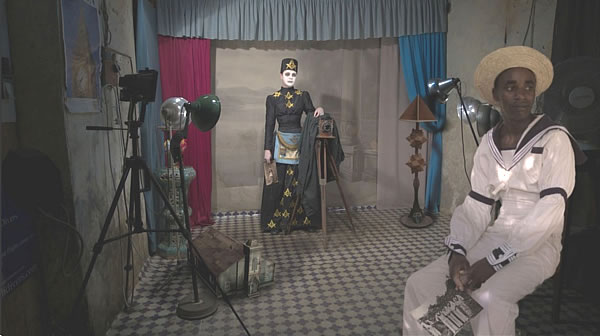One of the high points of the upcoming Autumn London art season will undoubtedly be Lindsay Seers’ Nowhere Less Now a project conceived specially for an arresting 19th century corrugated iron chapel in Kilburn, known locally as The Tin Tabernacle.
This ambitious new installation by British artist Lindsay Seers utilises the unlikely connections between the chapel, the birth of her great great uncle, George Edwards, the birth of Mina Bergson, artist and sister of French philosopher Henri Bergson, and her own birth exactly 100 years later to the day, Seers has created a journey across time. Entangling global histories with intimate stories, the work explores image-making mediums, sea-faring and migration.
One event leads to another in a world where coincidence takes on the character of necessity. The unfurling narratives project forward as well as backwards, from the present to a future when dates have become irrelevant and photography redundant.
The discovery by Seers of a family photograph of great great uncle Edwards, taken whilst serving with the British navy in Zanzibar, took her in his wake to the islands off Africa’s east coast. Many things came to the surface in this archipelago, considered to be the seat of witchcraft in East Africa; from an Arab princess and a young English sailor drifting in the currents of Empire, to an inscription on a centuries old Baobab tree.
Combining photography, performance, video and animation, Nowhere Less Now is symptomatic of Seers’ relentless search for truths that remain elusive as they slip through the lens.
The Tin Tabernacle is a Grade II listed building in Kilburn, London. Erected in the 1860s as a place of worship, for the last 70 years it has been home to the Willesden & St Marylebone Sea Cadets. It is one of the last surviving corrugated iron chapels in England.
Lindsay Seers studied at the Slade School of Art and Goldsmiths College in London during the 1990s. She has emerged as one of the most distinctive new figures in British art. Her installation Extramission 6 (Black Maria) was one of the highlights of Altermodern, the Tate Triennial in 2009. The same year, Seers exhibited It has to be this way at Matt’s Gallery in London. In 2010/11 Seers presented a sequel, It has to be this way² , commissioned by SMK (National Gallery of Denmark) and Mead Gallery, Warwick and presented by Baltic Centre for Contemporary Art, Gateshead.
Based in London but working across Britain and beyond, Artangel commissions and produces exceptional projects by outstanding contemporary artists. Over the past two decades, the projects have materialised in a range of different sites and situations and in countless forms of media.
Each new project evolves from a singular commissioning process, born from an open-ended conversation with an artist offered the opportunity to imagine something extraordinary. Artangel’s work is powered by the belief that artists are capable of creating visionary works which impact upon the way we view our world, our times and ourselves in unusual and enduring ways.
Many Artangel projects are given shape by a particular place and time. They can involve journeys to unfamiliar locations, from underground hangars to abandoned libraries. Or sometimes they can offer unfamiliar experiences in more familiar environments – a terraced house, a department store or daytime television.
This open-ended approach to the artistic process has seen Artangel generate some of the most talked-about, contentious and acclaimed art of recent times, including work by Francis Alÿs, Matthew Barney, Jeremy Deller, Douglas Gordon, Roni Horn, Steve McQueen, Michael Landy, Brian Eno, Gregor Schneider, Robert Wilson and Rachel Whiteread.

